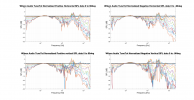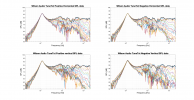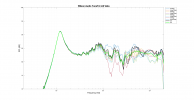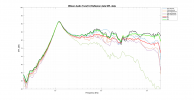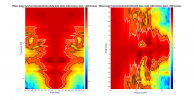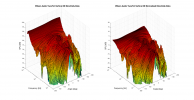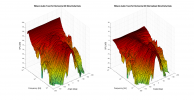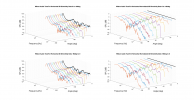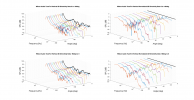This is a review and detailed measurements of the Wilson Audio TuneTot stand-mount/bookshelf speaker. It is on kind loan from a member and costs around US $10,000 (varies due to color).
View attachment 173759
I am not a fan of the way the front looks without the grill. The sides though sport probably the best finish I have seen on a speaker with deep gloss and polish. Speaker is also incredibly heavy and stiff for its size (29 pounds or 13 Kg). Drivers are custom versions of Scan-speak Revelator.
There is a down title rectangular port in the back:
View attachment 173760
I put in the very well designed dense foam plug that fits the port exceptionally well. In testing it really plugged the port unlike foam ones which half of the time feel like they are not doing anything.
Measurements that you are about to see were performed using the
Klippel Near-field Scanner (NFS). This is a robotic measurement system that analyzes the speaker all around and is able (using advanced mathematics and dual scan) to subtract room reflections (so where I measure it doesn't matter). It also measures the speaker at close distance ("near-field") which sharply reduces the impact of room noise.
Both of these factors enable testing in ordinary rooms yet results that can be more accurate than an anechoic chamber. In a nutshell, the measurements show the actual sound coming out of the speaker independent of the room.
Measurements are compliant with latest speaker research into what can predict the speaker preference and is standardized in CEA/CTA-2034 ANSI specifications. Likewise listening tests are performed per research that shows mono listening is much more revealing of differences between speakers than stereo or multichannel.
Reference axis was the center of the tweeter (aligned by eye). The grill was not used. It is getting colder with the measurement room temp at 14 degrees C. Accuracy is better than 1% for almost entire audio spectrum indicating a well designed speaker.
Wilson Audio TuneTot Measurements
Acoustic measurements can be grouped in a way that can be perceptually analyzed to determine how good a speaker is and how it can be used in a room. This so called spinorama shows us just about everything we need to know about the speaker with respect to tonality and some flaws:
View attachment 173761
On-axis response clearly doesn't look even. There is a massive peak around 115 Hz then real messiness around or near the crossover region. Directivity is lost around 3 kHz as well. Exploring the impact of the port, we see why that peak is there in bass:
View attachment 173762
Very strange to see the port tuned to boost the response at such a high frequency rather than extending it lower.
Oddly again, the sum of the early reflections is better behaved than on-axis:
View attachment 173763
This causes the predicted in-room response to be much smoother than you would expect from looking at our original spin graph:
View attachment 173764
As we could already guess, beamwidth is not uniform indicating room dependency:
View attachment 173765
Radiation pattern is wider than usual though which should give a more spacious impression than a point source around the speaker:
View attachment 173783
Vertically you lose some margin due to slanted baffle so best to not go above tweeter axis:
View attachment 173767
Distortion is kept very low at 86 dBSPL but I could hear a resonance during 96 dPSPL:
View attachment 173768
View attachment 173769
To rule out the Klippel stand from contributing to this, I literally held the speaker above it as the sweep ran and I could hear the resonance at a specific frequency. Strangely the frequency response drops there so the resonance must be out of phase. Here is the near-field response:
View attachment 173770
I only see minor variations of the woofer response so hard to say if the above is really the problem. I did like the fact that the port/cabinet resonances are kept low. Woofer response does step up some though and is reflected in the frequency response (between 700 Hz and 1 kHz). Is this due to too little baffle compensation?
Impedance is above average which should make it easier on the amplifier:
View attachment 173772
There is a sign of that resonance at 2.6 kHz that we saw in the distortion measurements.
Waterfall response shows a number of resonances corresponding with peaks in response:
View attachment 173771
For fans of timing analysis, here are the impulse and step response (yes, phase is inverted -- I need to fix this):
View attachment 173773
View attachment 173774
Wilson TuneTot Listening Tests and Equalization
Listening test system was a custom, silent Roon Server/Player ($2,000) connected to Matrix X-Sabre MQA DAC ($2,000), and Mark Levinson Reference Amplifier ($20,000, 400 watts/channel) playing custom tracks developed for testing headphones and speakers.
I started playing with the port open. With my female vocal tracks, the extra bass was not all that bad and compensated partially the slight brightness of the speaker. But when I played content with much bass content, it became overwhelming. I plugged the port but then there was not much bass to satisfy. So I removed the plug and deployed a few filters:
View attachment 173775
The first dip should be self-explanatory to remove the extra bass boost. Doing this from anechoic measurements is tricky though as in-room response likely looks very different. So I adjusted this by ear and admittedly on some tracks I wanted slightly more of it. With this filter in place the bass was now tighter and overall sound of the speaker more open. Per above though, there was some brightness that gave me hell to deal with. Likely due to bad directivity and mismatch of on and off-axis, using an electronic filter that impacts both is very challenging.
I eventually gave up on optimizing using on-axis response and roughly used the Predicted In-Room Response (by eye) to develop the two other mild filters. I performed a number of blind tests and overall I preferred the equalized response. There is a caveat that you need to know what good and clean bass is and the overall proper tonality. Otherwise, the "showroom sound" aspect of this speaker can be seductive making you want to listen to boosted bass and slightly elevated highs.
For comparison, I switched back and forth a dozen times with Revel M106 speaker ($2,000). The Revel had a smaller halo and sounded more focused than the TuneTot. It had none of the brilliance of the Tunetot but his was a dual edged sword in that the TuneTot constantly gave the impression of a more detailed, and "audiophile" high frequency notes that were very nicely delineated. TuneTot also had deeper and cleaner bass response than the M106. Overall, I preferred the TuneTot over Revel.
I briefly compared the TuneTot to my Revel Salon 2 ($23,000). Revel did not have the exaggerated spatial qualities of the high frequencies that TuneTot had but overall presented a much more balanced tonality and of course, much more bass impact. Its midrange was so smooth and nice. Still, I was amazed how the TuneTot did not sound small compared to it whereas the M106 did.
Sub-bass response on TuneTot was better than I expect from a small speaker. Push it though and the woofer starts to make bad sounds as they all do in this size factor and playback levels.
Conclusions
There is no question that there are some clear objective/engineering errors in the design of Wilson TuneTot. The port is tuned too high and the on-axis/directivity response is poor. What is strange though that the impact of these on the fidelity of the speaker is not at all this obvious. Either I am influenced by the showroom sound as much as the next guy or getting off-axis to be right in my rather reflective room overcomes issues in on-axis response. It is also possible that all the money that has gone to building such an extremely dense speaker and keeping distortion low is paying benefit here. One wonders how much better these would sound if they had had preserved all of this and at the same time didn't have the design errors.
If I were to just goy by the measurements, the Tunetot would not get good marks. But I have promised you all that I won't lie about what I hear no matter how much of a conflict this provides. To that end,
I am going to recommend the Wilson TuneTot with equalization (cost not considered).

